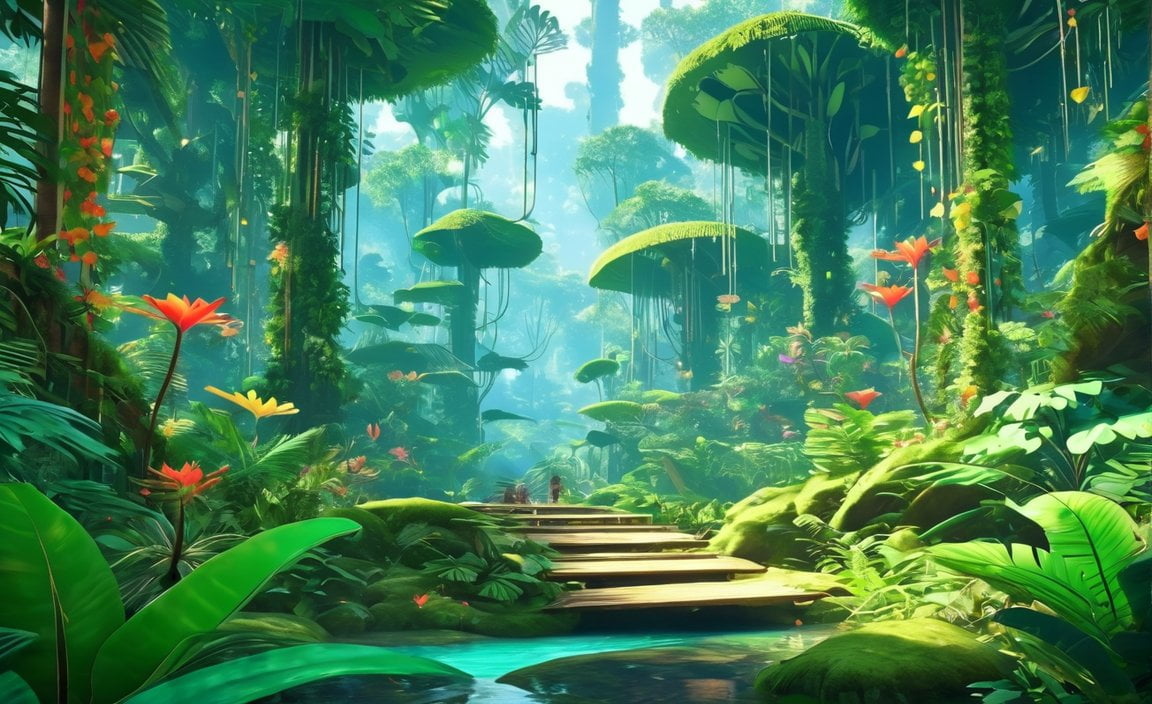Delve Into the Tropical Rainforest: 10 Vital Facts
Embark on a captivating journey through the enchanting world of the tropical rainforest biome, as we unravel 10 vital and fascinating facts about it. As a seasoned environmental journalist with a deep love for our planet’s diverse ecosystems, I have gathered extensive knowledge and conducted in-depth research into the intricate mysteries of this lush and vibrant biome. Through my expertise in data analysis and storytelling, I aim to bring you a concise and accessible exploration into the wonders and importance of the tropical rainforest. Join me as we delve into this extraordinary realm and uncover the secrets that lie within.
Key Takeaways:
- Rainforests cover less than 2% of Earth’s surface but are home to 50% of its plants and animals.
- Rainforests have high biodiversity, housing half of all living animal and plant species.
- Two-thirds of all flowering plants can be found in rainforests.
- Rainforests are a valuable source of medicinal plants.
- A single hectare of rainforest can contain thousands of insect species, hundreds of tree species, and numerous plant species.
- Rainforests play a crucial role in regulating the Earth’s temperature.
- Rainforests provide food resources for people.
- Rainforests have an equatorial climate.
- Rainforests have distinct layers, including the emergent, canopy, understory, and forest floor.
- Latin American rainforests are home to black howler monkeys, known for their long-distance calls.
10 Facts About the Tropical Rainforest Biome

The tropical rainforest biome is a captivating and diverse ecosystem that covers less than two percent of the Earth’s surface. Despite its small size, it is home to a staggering fifty percent of the Earth’s plants and animals. Let’s delve into this fascinating world and explore ten vital facts about the tropical rainforest biome.
1. Unparalleled Biodiversity
The rainforests boast unparalleled biodiversity, housing approximately half of all living animal and plant species on our planet. This incredible array of life forms includes exotic birds, reptiles, amphibians, mammals, and an astonishing number of insect species. It’s truly a treasure trove of biodiversity.
2. Medicinal Properties
The lush greenery of rainforests is not just visually stunning; it also holds immense medicinal value. Many lifesaving drugs, such as quinine for treating malaria and vincristine for cancer, have been derived from plants found in the rainforest. Scientists continue to explore the vast potential of this natural pharmacy for future medical breakthroughs.
3. Flourishing Flora
Rainforests are a haven for plants, with two-thirds of all flowering plant species thriving in their depths. From aromatic orchids to towering trees and vibrant ferns, the diversity of plant life is unparalleled. These plants play a vital role in maintaining the delicate balance of the rainforest ecosystem.
4. A Biodiversity Hotspot
A single hectare of rainforest can harbor an astounding number of different species. In fact, it may contain up to 42,000 species of insects, 807 trees belonging to 313 different species, and a staggering 1,500 species of higher plants. The rainforest biome truly showcases the richness and complexity of Earth’s biodiversity.
5. Climate Regulation
Rainforests play a crucial role in regulating the Earth’s climate. The dense foliage of the rainforest acts as a natural carbon sink, absorbing and storing vast amounts of carbon dioxide, the main greenhouse gas responsible for global warming. It helps maintain the delicate balance of our planet’s climate system.
6. Abundant Food Source
Rainforests not only sustain a diverse range of wildlife but also provide vital resources for humans. Many fruits, nuts, and spices that we enjoy regularly, such as bananas, cocoa, and vanilla, are native to rainforests. Additionally, indigenous communities rely on rainforest resources for sustenance and traditional practices.
7. Equatorial Conditions
The tropical rainforest biome is predominantly found near the equator, where it benefits from abundant sunlight and a consistent warm climate throughout the year. The combination of high temperatures and ample rainfall creates the ideal conditions for the lush growth of vegetation.
8. Vertical Layering
Rainforests exhibit an intriguing vertical structure, with distinct layers comprising the emergent layer, canopy layer, understory layer, and forest floor. Each layer supports unique plants and animals adapted to its specific conditions, contributing to the overall complexity and beauty of the rainforest biome.
9. Distinctive Rainforest Inhabitants
Rainforests are home to a fascinating array of creatures, each contributing to the intricate web of life. For example, the black howler monkeys found in Latin American rainforests have unique vocalizations that can be heard from almost 5 kilometers away. Similarly, tropical rainforests house veiled stinkhorn fungi, which emit a strong odor resembling rotting food.
10. Human-Rainforest Connection
Throughout history, rainforests have played an integral role in the lives of indigenous communities. For instance, the Korowai people of New Guinea construct tree houses as high as 45 meters off the ground to protect themselves from floods and predators. These remarkable adaptations demonstrate the deep connection between humans and the tropical rainforest biome.
In conclusion, the tropical rainforest biome is an awe-inspiring ecosystem that holds remarkable biodiversity, medicinal treasures, and crucial climate regulation properties. By understanding and appreciating these ten vital facts, we can foster greater awareness and support for the preservation of this extraordinary biome.
Did you know that the River Severn has some fascinating facts? Discover 10 of them by clicking here for interesting insights about this iconic river.
If you’re curious about rivers in general, we’ve got you covered! Click here to explore 10 captivating facts about rivers that will leave you amazed.
Outline 3: Importance of tropical rainforests for climate regulation
The tropical rainforest biome is not only a unique and diverse ecosystem but also plays a crucial role in the regulation of the Earth’s climate. In this article, we will delve into the tropical rainforest and explore 10 vital facts about its importance for climate regulation.
Tropical Rainforests: Earth’s Climate Guardians
Fact 1: Carbon Sinks
– Tropical rainforests act as large carbon sinks, absorbing and storing carbon dioxide from the atmosphere.
– They hold an astonishing 360 Pg of carbon in their forest vegetation, helping to offset the effects of climate change.
– This makes them key players in regulating the composition of the atmosphere and maintaining a stable climate.
Fact 2: Oxygen Release
– Besides absorbing carbon dioxide, tropical rainforests release vast amounts of oxygen into the atmosphere, ensuring the balance necessary for life on Earth.
– Their ability to stabilize the Earth’s climate by regulating gas concentrations is paramount.
Fact 3: Climate Regulation
– The dense canopies and wide array of vegetation in tropical rainforests contribute to regulating the Earth’s climate.
– They influence the water cycle and the balance of radiation through a phenomenon called albedo, maintaining a harmonious equilibrium.
Fact 4: Enhanced Hydrology
– Through their vast network of roots and canopy interception, tropical rainforests extensively influence the hydrological cycle.
– They help to regulate rainfall patterns and contribute to the distribution of rainfall in vast areas of the globe.
Fact 5: Temperature Control
– The dense vegetation cover of tropical rainforests provides shade, keeping temperatures lower within their boundaries.
– This cooling effect has a significant impact on maintaining a stable climate and moisture balance.
Fact 6: Biodiversity and Ecosystem Resilience
– Tropical rainforests support unparalleled biodiversity, housing approximately half of all living animal and plant species.
– This diverse ecosystem plays a vital role in maintaining a robust and resilient biosphere, contributing to global ecosystem stability.
Fact 7: Crucial Water Filters
– The roots of rainforest trees act as natural filters, purifying water by removing toxins and pollutants.
– The pristine water originating from these forests is essential for local communities and downstream ecosystems.
Fact 8: Global Climate Stabilizers
– Tropical rainforests contribute to stabilizing regional and global climates by maintaining a delicate balance in atmospheric moisture levels.
– This equilibrium is the foundation for tasks such as cloud formation and precipitation, crucial for sustaining life on Earth.
Fact 9: Greenhouse Gas Regulation
– By absorbing greenhouse gases, particularly carbon dioxide, tropical rainforests play a crucial role in mitigating climate change.
– Their capacity to sequester carbon is a valuable asset in reducing the concentration of greenhouse gases in the atmosphere.
Fact 10: Ecosystem Interconnections
– The interconnected nature of ecosystems highlights the significance of tropical rainforests for climate regulation.
– By maintaining their integrity, we ensure the preservation of countless ecological services that benefit both nature and humans alike.
Key Takeaways:
- Tropical rainforests act as carbon sinks, absorbing carbon dioxide and helping offset the effects of climate change.
- They release significant amounts of oxygen, maintaining the atmospheric balance necessary for life.
- The dense canopies and vegetation in tropical rainforests contribute to climate regulation through influencing the water cycle and radiation balance.
- Their impact on the hydrological cycle helps regulate rainfall patterns and distribution.
- Tropical rainforests provide shade, contributing to temperature control and maintaining a stable climate.
- The high biodiversity of tropical rainforests supports ecosystem resilience and stability.
- Rainforests function as crucial water filters, purifying water and benefiting local communities and ecosystems.
- They contribute to stabilizing regional and global climates by maintaining atmospheric moisture levels.
- Tropical rainforests sequester greenhouse gases, such as carbon dioxide, mitigating climate change.
- The interconnections between ecosystems emphasize the importance of preserving tropical rainforests for climate regulation.
Sources:
- PLOS – Tropical forests are crucial in regulating the climate on Earth
- BBC – Tropical rainforests – Edexcel Importance of the tropical rainforest
Outline 4: Threats to the Tropical Rainforest Biome

As we delve into the fascinating world of the tropical rainforest biome, it is essential to acknowledge the significant threats that pose a danger to its existence. These threats not only jeopardize the delicate balance of this intricate ecosystem but also impact the planet as a whole. Let’s explore the ten vital facts about the threats to the tropical rainforest biome and understand the urgent need for conservation efforts.
1. Unsustainable Logging:
Unregulated logging practices pose a severe threat to the tropical rainforest biome. Deforestation for timber extraction disrupts the natural habitat of countless plant and animal species, leading to biodiversity loss and ecological imbalance. Moreover, the cleared land often paves the way for further exploitation.
2. Unsustainable Agriculture:
The expansion of agriculture, particularly for the cultivation of cash crops like palm oil, soybeans, and cattle grazing, is a significant threat to the tropical rainforest biome. Large-scale farming practices often involve clear-cutting vast areas of the rainforest, causing irreversible damage to this valuable ecosystem.
3. Mining and Extractive Industries:
The mining industry, driven by the demand for valuable minerals and resources, poses a significant threat to the tropical rainforest biome. The extraction of minerals such as gold, zinc, and coal involves clearing extensive areas of forest, polluting water bodies, and disrupting delicate ecosystems.
4. Oil Extraction:
Oil extraction, be it for fossil fuels or palm oil production, poses a severe threat to the tropical rainforest biome. Spills and leaks from oil infrastructure not only contaminate water sources but also destroy the habitat of countless species, leading to long-term ecological damage.
5. Hydro-electric Power Dams:
While hydro-electric power dams offer renewable energy solutions, they also pose a threat to the tropical rainforest biome. Large dams often require the flooding of vast areas, leading to the submergence of forests and the displacement of local communities. This disrupts the delicate equilibrium of the rainforest ecosystem.
6. Wildfires:
Wildfires, whether caused naturally or by human activities, are a significant threat to the tropical rainforest biome. Not only do they lead to immediate destruction of vast areas of forest, but they also increase the vulnerability of the ecosystem to subsequent threats such as erosion and invasive species.
7. Droughts and Storms:
Climate change-induced droughts and storms pose a severe threat to the tropical rainforest biome. Increased frequency and intensity of such extreme weather events can lead to prolonged droughts, forest fires, and widespread devastation, causing irreparable harm to this delicate ecosystem.
8. Volcanic Activity:
Volcanic eruptions can have profound effects on the tropical rainforest biome. While volcanic ash can enrich the soil, the initial destruction and subsequent alterations in the ecosystem can pose a significant challenge to the survival of numerous plant and animal species.
9. Human Population Growth:
The steady growth of the global human population places immense pressure on the tropical rainforest biome. As the population expands, there is an increased demand for land, resources, and settlement, resulting in widespread deforestation and habitat destruction.
10. Climate Change:
Perhaps the most significant threat to the tropical rainforest biome is climate change. Rising temperatures, altered precipitation patterns, and increased frequency of extreme weather events disrupt the delicate balance of this ecosystem, leading to habitat loss and species extinction.
Key Takeaways:
– Unsustainable logging practices disrupt the natural habitat of plant and animal species.
– Expanding agriculture leads to deforestation and irreversible damage to the rainforest.
– Mining and oil extraction cause extensive forest clearing and ecological disruption.
– Hydro-electric power dams submerge forests and displace local communities.
– Wildfires, droughts, storms, and volcanic activity pose immediate threats to the rainforest.
– The increasing human population drives deforestation and habitat destruction.
– Climate change alters temperatures, precipitation patterns, and extreme weather events, impacting the rainforest ecosystem.
Citation:
- National Geographic: “A team of top scientists, brought together by the National Geographic Society, built an index to detect which rainforests are most vulnerable” (National Geographic).
- Young People’s Trust For the Environment: “In just the last 50 years, one third of tropical rainforests have been destroyed, with 46-58 thousand square miles of forest lost each year” (Young People’s Trust For the Environment).
- Earth Eclipse: “There are 15 serious threats to the rainforest, including logging, unsustainable agriculture, cattle grazing, mining, oil extraction, hydro-electric power dams, wildfires, droughts, storms, volcanic activity, and human population growth” (Earth Eclipse).
- Earth Eclipse: “The population of humans is estimated to reach 9 billion by 2050, leading to increased deforestation for settlement space and profit” (Earth Eclipse).
- Sciencing: “Tropical rainforests cover less than two percent of the Earth’s surface but have important roles as a source of medicine, regulator of temperatures and weather patterns, and a habitat for high biodiversity” (Sciencing).
- Khan Academy: “The tropical rainforest biome has four main characteristics: very high annual rainfall, high average temperatures, nutrient-poor soil, and high levels of biodiversity” (Khan Academy).
[Outline 5: Conservation efforts and the role of individuals in protecting tropical rainforests]
The tropical rainforest biome is not only a treasure trove of biodiversity but also a vital component in the fight against climate change. It is essential that we take immediate action to protect these invaluable ecosystems. In this article, we will delve into the various conservation efforts being made and explore the crucial role that individuals play in safeguarding tropical rainforests.
Conservation Efforts: An Urgent Need
Rainforests face numerous threats, including deforestation, illegal logging, and unsustainable agriculture. To combat these challenges, governments, international organizations, and local communities have been working tirelessly to establish effective conservation strategies. Here are five vital conservation efforts being implemented:
Enforcing Laws: Governments around the world are taking steps to protect rainforests by enacting and enforcing legislation to curb deforestation. These laws play a crucial role in preserving the integrity of these ecosystems and ensuring their sustainability.
Sustainable Management: Sustainable management practices are being implemented to strike a balance between the needs of local communities and the preservation of rainforests. Responsible logging, reforestation programs, and ecotourism initiatives are being promoted to generate income for local communities while minimizing the impact on these fragile ecosystems.
International Collaboration: Collaborative efforts at the international level are paramount in protecting rainforests. Initiatives like REDD+ (Reducing Emissions from Deforestation and Forest Degradation) and international agreements are crucial in aligning global efforts towards forest conservation and climate change mitigation.
Financial Support: Adequate financial support is crucial for the long-term protection of rainforests. Developed nations and international organizations should provide funding for sustainable forest management, conservation programs, and initiatives that promote local livelihoods.
Education and Awareness: Creating awareness about the importance of rainforests and the role they play in our planet’s health is key to engaging individuals in the conservation effort. Education campaigns and programs that highlight the value of rainforests are essential for instilling a sense of responsibility and inspiring action.
The Role of Individuals: Making a Difference
While governments and organizations play a vital role in protecting rainforests, individuals also have the power to make a difference. Here are five ways in which individuals can contribute to the conservation of tropical rainforests:
Conscious Consumerism: By making informed choices, individuals can support sustainable products and avoid contributing to rainforest destruction. This includes opting for deforestation-free products, such as certified sustainable wood and palm oil, and supporting companies that prioritize environmental sustainability.
Reduce, Reuse, Recycle: Practicing the three R’s can significantly reduce our impact on rainforests. By reducing consumption, reusing items, and recycling materials, we can minimize the need for resource extraction and help preserve rainforest habitats.
Support Rainforest-friendly Initiatives: Individuals can actively support organizations and initiatives dedicated to rainforest conservation. This can be done through donations, volunteering, or even participating in advocacy campaigns.
Educate and Spread Awareness: Sharing knowledge about the importance of rainforests with friends, family, and colleagues can help raise awareness and inspire others to take action. Engaging in conversations, sharing articles and documentaries, and using social media platforms are effective ways to spread the message.
Get Involved Locally: Individuals can make a difference at the grassroots level by getting involved in local conservation efforts. This can include participating in tree-planting activities, joining community-led initiatives, or volunteering with local environmental organizations.
By combining efforts at the global, national, and individual levels, we can increase the chances of preserving tropical rainforests for future generations. Each individual action, no matter how small, contributes to the larger goal of protecting these incredible ecosystems.
Key Takeaways:
- Conservation efforts are crucial for safeguarding tropical rainforests from threats like deforestation and unsustainable practices.
- Enforcing laws, implementing sustainable management practices, promoting international collaboration, and providing financial support are vital conservation strategies.
- Individuals can make a difference by practicing conscious consumerism, reducing waste, supporting rainforest-friendly initiatives, spreading awareness, and getting involved locally.
- The collective effort of governments, organizations, and individuals is essential in ensuring the long-term preservation of tropical rainforests.
Sources:
1. The World Economic Forum – 4 vital steps to protect the world’s remaining rainforests
2. FAO – Conservation and protection of tropical rainforests
FAQ
Q1: How much of the Earth’s surface do rainforests cover?
A1: Rainforests cover less than two percent of the Earth’s total surface.
Q2: What percentage of the Earth’s plants and animals can be found in rainforests?
A2: Rainforests are home to fifty percent of the Earth’s plants and animals.
Q3: How many species of flowering plants can be found in rainforests?
A3: Two-thirds of all flowering plants can be found in rainforests.
Q4: What are the main layers in a rainforest?
A4: Rainforests have different layers, including the emergent layer, canopy layer, understory layer, and forest floor.
Q5: What are some threats to rainforests?
A5: Some threats to rainforests include logging, unsustainable agriculture, cattle grazing, mining, oil extraction, hydro-electric power dams, wildfires, droughts, storms, volcanic activity, and human population growth.
- Amazing March Fun Facts: Unveiling History & Celebrations - April 15, 2025
- Master how to write height: A complete guide - April 15, 2025
- How High Are Your Standards Test: Find Your Perfect Match Now - April 15, 2025
















